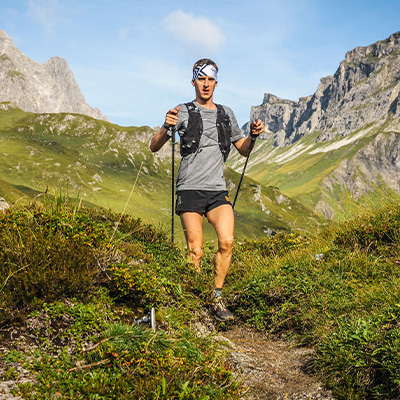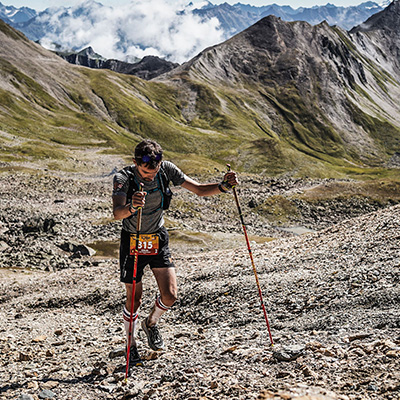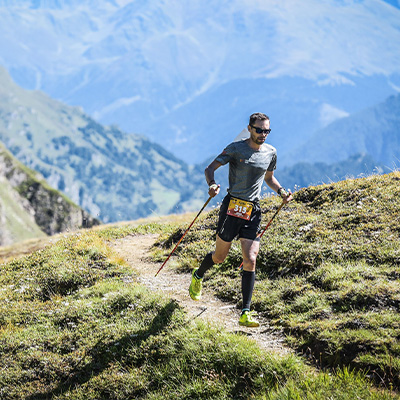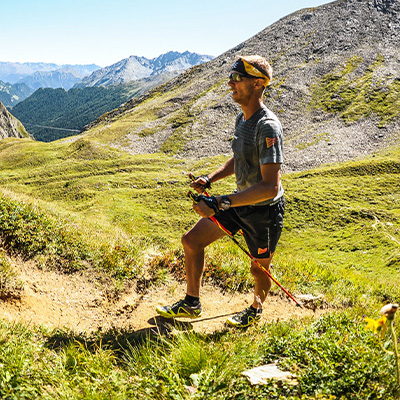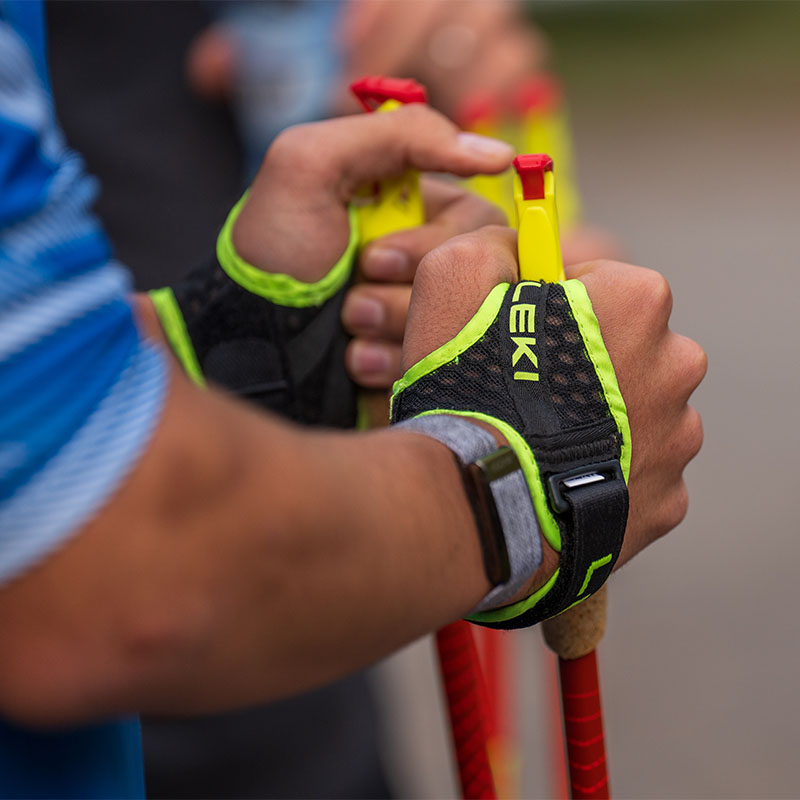LEKI running poles - a comparison
Featherlight, yet incredibly strong - that's what all LEKI poles have in common. But what are the main differences between the various models? And how do you know which poles are right for you? We explain it all below.
When and why should I use running poles?
Trail poles offer a huge advantage during your trail runs or hikes. But whether you always need them is another question. In the relatively flat region of Flanders, trail poles are often overkill. You could use them for the modest hills of the Ardennes, but it's only in the high mountains that they truly comes into their element.
How to choose the right running poles?
There are three key factors to consider when choosing your running poles: the grip system, the length, and the weight of the poles.
1. The grip system: open loop or glove?
The open loop
Tip: it's important to wear the loop correctly. Be sure to watch a tutorial before getting started.
Advantages:
- More freedom of movement and easier access. You can release your hands from the poles more quickly. This is especially helpful for orienteering runners who need to navigate on the go.
- Cooler and more breathable. In warmer conditions, an open loop feels cooler than a glove. It allows better airflow and helps keep your hands from overheating.
- Safer for beginners. If you're not yet fulle experienced on the trails, an open loop can help prevent bad falls. A glove attaches the pole firmly to your hand, making it harder to let go quickly if you trip. With a loop, it's easier to react and catch yourself.
Disadvantages
- It requires more technique. To use the poles effectively and transfer your power efficiently, you'll need to master a bit more technique.
Trigger Shark systeem
A.k.a. the glove
Advantages:
- Intuitive power transfer: there's less play between your hand and the pole, resulting in more direct and efficient power transfer.
- Warmth and insulation. The glove provides some warmth, which can be a plus in colder conditions like winter or in high mountain environments.
- Convenient click system. The glove features a click-in system, allowing you to quickly and eaily detach your poles and stow them when you don't need them.
Disadvantages
- Less freedom of movement. You're less free to quickly do things like read a map or grab something on the go.
- Harder to anticipate falls. If you're about to fall, you can't easily let go of the pole, increasing the risk of wrist impact.
- Warmer and less breathable. Glvoes are warmer and less ventilated than loops, which can lead to sweaty hands, especially in summer conditions.
Jim Walmsley, UTMB winner in 2023, will usually opt for the gloves.
"The Shark system offers the ultimate power transfer. It improves my technique and delays fatigue. Only when the course includes a lot of climbing sections where I need my hands to scramble, i'll go for an open loop instead", says the experienced trail runner.
2. The length of the poles
The second key factor is the length of the poles. Choosing the right size is important. Usually, the packaging will indicate which height the poles are suitable for, but you can also test it yourself by just experiencing.
Make a 90-degree angle with your elbow and grip the handle of the pole at that height. If the pole is standing vertically on the ground and your back remains straight, you've found the correct length.
As a hiker, you can adjust that length depending on the terrain. To keep a straight back while walking, shorten the poles slightly when going uphill and lengthen them a bit when descending.
3. The weight of the poles
A final factor to consider is the weight of the poles. The lighter the pole, the more efficiently you can run with it.
The difference in weight comes down to the materials used. The most common materials are carbon and aluminium.
Carbon is the lighter of the two. It's also stiffer, which makes it ideal for more technical terrain and longer trail runs. However, carbon is slightly more fragile and has a higher risk of breaking.
Aluminium on the other hand, is a bit heavier but offers more durability and lower risk of breakage.
An overview of the LEKI poles
Feature | ||||
Grip | Open loop | Open loop | Glove (Trigger Shark) | Glove (Trigger Shark) |
Power transfer | Somewhat more technical | Somewhat more technical | Direct and intuitive | Direct and intuitive |
Ease of use when reading a map | Suitable | Suitable | Less suitable | Less suitable |
Warmth/isolation | No isolation | No isolation | Warmer, bit of isolation | Warmer, bit of isolation |
Safety when falling | Quick release possible | Quick release possible | Not easy to release | Not easy to release |
Weight | 121g/pole | 178g/pole | 175g/pole | 126g/pole |
Length | 105-130cm | 110-130cm | 105-135cm | 100-130cm |
Price | €159,95 | €184,95 | €179,95 | €189,95 |
Get peronalized advice
Not sure which poles you need? Visit one of our Runners' lab stores. Our experienced advisors will provide you with tips on using trail running poles, and let you try them out ro make sure you choose the right size and model.
LEKI running poles - a comparison
Featherlight, yet incredibly strong - that's what all LEKI poles have in common. But what are the main differences between the various models? And how do you know which poles are right for you? We explain it all below.
When and why should I use running poles?
Trail poles offer a huge advantage during your trail runs or hikes. But whether you always need them is another question. In the relatively flat region of Flanders, trail poles are often overkill. You could use them for the modest hills of the Ardennes, but it's only in the high mountains that they truly comes into their element.
How to choose the right running poles?
There are three key factors to consider when choosing your running poles: the grip system, the length, and the weight of the poles.
1. The grip system: open loop or glove?
The open loop
Tip: it's important to wear the loop correctly. Be sure to watch a tutorial before getting started.
Advantages:
- More freedom of movement and easier access. You can release your hands from the poles more quickly. This is especially helpful for orienteering runners who need to navigate on the go.
- Cooler and more breathable. In warmer conditions, an open loop feels cooler than a glove. It allows better airflow and helps keep your hands from overheating.
- Safer for beginners. If you're not yet fulle experienced on the trails, an open loop can help prevent bad falls. A glove attaches the pole firmly to your hand, making it harder to let go quickly if you trip. With a loop, it's easier to react and catch yourself.
Disadvantages
- It requires more technique. To use the poles effectively and transfer your power efficiently, you'll need to master a bit more technique.
Trigger Shark systeem
A.k.a. the glove
Advantages:
- Intuitive power transfer: there's less play between your hand and the pole, resulting in more direct and efficient power transfer.
- Warmth and insulation. The glove provides some warmth, which can be a plus in colder conditions like winter or in high mountain environments.
- Convenient click system. The glove features a click-in system, allowing you to quickly and eaily detach your poles and stow them when you don't need them.
Disadvantages
- Less freedom of movement. You're less free to quickly do things like read a map or grab something on the go.
- Harder to anticipate falls. If you're about to fall, you can't easily let go of the pole, increasing the risk of wrist impact.
- Warmer and less breathable. Glvoes are warmer and less ventilated than loops, which can lead to sweaty hands, especially in summer conditions.
Jim Walmsley, UTMB winner in 2023, will usually opt for the gloves.
"The Shark system offers the ultimate power transfer. It improves my technique and delays fatigue. Only when the course includes a lot of climbing sections where I need my hands to scramble, i'll go for an open loop instead", says the experienced trail runner.
2. The length of the poles
The second key factor is the length of the poles. Choosing the right size is important. Usually, the packaging will indicate which height the poles are suitable for, but you can also test it yourself by just experiencing.
Make a 90-degree angle with your elbow and grip the handle of the pole at that height. If the pole is standing vertically on the ground and your back remains straight, you've found the correct length.
As a hiker, you can adjust that length depending on the terrain. To keep a straight back while walking, shorten the poles slightly when going uphill and lengthen them a bit when descending.
3. The weight of the poles
A final factor to consider is the weight of the poles. The lighter the pole, the more efficiently you can run with it.
The difference in weight comes down to the materials used. The most common materials are carbon and aluminium.
Carbon is the lighter of the two. It's also stiffer, which makes it ideal for more technical terrain and longer trail runs. However, carbon is slightly more fragile and has a higher risk of breaking.
Aluminium on the other hand, is a bit heavier but offers more durability and lower risk of breakage.
An overview of the LEKI poles
Feature | ||||
Grip | Open loop | Open loop | Glove (Trigger Shark) | Glove (Trigger Shark) |
Power transfer | Somewhat more technical | Somewhat more technical | Direct and intuitive | Direct and intuitive |
Ease of use when reading a map | Suitable | Suitable | Less suitable | Less suitable |
Warmth/isolation | No isolation | No isolation | Warmer, bit of isolation | Warmer, bit of isolation |
Safety when falling | Quick release possible | Quick release possible | Not easy to release | Not easy to release |
Weight | 121g/pole | 178g/pole | 175g/pole | 126g/pole |
Length | 105-130cm | 110-130cm | 105-135cm | 100-130cm |
Price | €159,95 | €184,95 | €179,95 | €189,95 |
Get peronalized advice
Not sure which poles you need? Visit one of our Runners' lab stores. Our experienced advisors will provide you with tips on using trail running poles, and let you try them out ro make sure you choose the right size and model.


